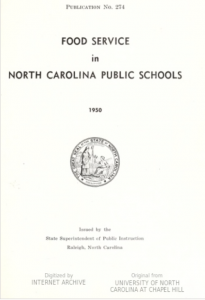
Colin Thompson
This report “Food Service in North Carolina Public Schools (1950)” plays a great part in the “food story” of Chapel Hill during its time. Specifically, this report reflects the importance that state officials and other organizers placed on providing students with quality service during the school day. This object is important in its “post-war” time, because it conveys the climate of not only the area, but of the nation after World War II.
This object provides us with a “micro-glance” into a specific area’s post-World War II attitude. After a brutal war that made Americans really reflect upon their own values, the idea of providing quality lunches to all students in North Carolina schools reflects those ideals that many Americans had. After seeing the horrors of discrimination and hate in Nazi Germany, many Americans were attempting to put as much distance between themselves and the Nazi regime as possible.
The fact that this report provided specific instructions for serving lunches to students in particular, is also very indicative of the goals many Americans had at the time. The students were the young and promising Americans, and this report named very specific procedures on how to best serve them. The report aims to facilitate lunches during the school day, so the students could make as many advances as possible, which would display the United States of America’s strength to the rest of the world.
The amount of detail that these directions for serving school lunches had is just another thing that emphasizes the report’s goal of attempting to make a positive impact on a daily basis in the lives of school children. At the end of the report, the author (the state superintendent) expresses his hopes for it. He says that he believes these instructions can serve as “a guide” for making students’ “food experiences” as positive as possible.
Work Cited
North Carolina. Department of Public Instruction. Food Service in North Carolina Public Schools. United States, 1950.